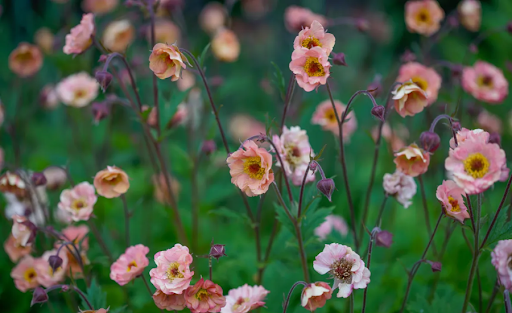Geum: The Ultimate Guide to Avens — A Hardy Perennial Treasure for Every Garden
If you want to learn about geum, you’re in the right place. Geum, often called avens, is a genus consisting of roughly 50 species of perennial herbaceous plants in the rose family (Rosaceae). These plants are native to temperate regions of the Northern Hemisphere, especially Europe, Asia, and North America. Known for their vibrant, colorful flowers and resilient growth habits, geum species are a favorite among gardeners and botanists alike.
Geum plants typically produce beautiful blooms ranging from yellow and orange to red and pink, often lasting from late spring through early summer. Their hardy nature and ability to adapt to a variety of environments make them an excellent choice for both formal gardens and naturalized landscapes. Whether you’re a seasoned horticulturist or just starting to explore perennials, understanding geum’s characteristics, cultivation, and uses can enhance your gardening experience significantly.
Understanding the Genus Geum: Origins, Classification, and Distribution
Botanical Classification and Etymology
Geum belongs to the Rosaceae family, a large group of flowering plants that includes roses, strawberries, and apples. Within this family, geum falls under the subfamily Rosoideae, characterized by herbaceous perennials with distinctive flowers. The genus name “Geum” is believed to originate from the Greek word “geuon,” meaning “taste” or “flavor.” This refers to the aromatic qualities of some species’ roots, which were historically used for medicinal purposes.
Geographic Distribution and Natural Habitats
Geum species naturally occur across the temperate zones of the Northern Hemisphere. You’ll find them in various environments, from moist woodlands and meadows to rocky alpine slopes. In Europe, species such as Geum urbanum (wood avens) are common in shaded forests, while in North America, species like Geum triflorum (prairie smoke) thrive in open prairies and grasslands.
Their broad habitat range reflects the genus’s versatility. Some geum species prefer partial shade and cooler climates, while others tolerate full sun and drier soils, making them adaptable to diverse garden settings worldwide.
Key Botanical Features of Geum Plants
Growth Habit and Root Structure
One of the most notable features of geum plants is their rhizomatous root system. Rhizomes are underground stems that grow horizontally, allowing the plant to spread and form dense clumps or colonies over time. This characteristic helps geum maintain longevity in the garden and resist harsh weather conditions.
Geum plants are herbaceous perennials, meaning they die back to the ground in winter but regrow from their roots each spring. Typically, their height ranges from 30 cm (12 inches) to about 60 cm (2 feet), depending on the species and growing conditions.
Leaves and Stems
Geum leaves are generally pinnate or lobed with serrated edges, giving them a textured appearance that adds ornamental value even when the plant is not in bloom. The basal leaves often form rosettes close to the ground, while the flowering stems bear smaller, alternate leaves.
The stems are usually slender but sturdy, supporting clusters of small, delicate flowers. Depending on the species, stems can be slightly hairy or smooth.
Flower Characteristics
Flowers are the main attraction of geum plants. They feature five petals and a central cluster of stamens, typical of the rose family’s floral structure. The petals come in warm, inviting shades—yellows, oranges, reds, pinks, and occasionally white. The blooms tend to be cup-shaped or slightly nodding and appear in loose clusters at the top of the stems.
Flowering usually occurs from late spring to early summer, though some species bloom longer or sporadically throughout the growing season. The blossoms are excellent at attracting pollinators like bees, butterflies, and hummingbirds, supporting biodiversity in the garden.
Popular Species and Cultivars of Geum
Geum Urbanum (Wood Avens)
This species is native to Europe and is easily recognizable by its yellow-orange flowers and aromatic roots. Wood avens typically grow in shaded or semi-shaded woodland areas. It has been historically used in herbal medicine for digestive and respiratory ailments.
Geum Rivale (Water Avens)
Known for its nodding, bell-shaped flowers that range from pink to purple, water avens thrive in damp, marshy environments. They are often found near streams and wet meadows. This species offers a more delicate floral display and adds a wild charm to garden water features.
Geum Coccineum (Scarlet Avens)
This species produces striking, bright red or scarlet flowers. It is favored for its vivid color and longer blooming period, making it a popular choice for gardeners who want a splash of boldness in their flower beds.
Geum Triflorum (Prairie Smoke)
Native to North America, prairie smoke features unique, feathery seed heads that resemble smoke or wisps drifting in the breeze, hence its name. The flowers are typically soft pink to reddish and bloom early in the season. It prefers open, sunny habitats.
Cultivars and Hybrids
Hybridization has resulted in many beautiful garden cultivars, combining the best traits of various species. Popular garden hybrids like ‘Totally Tangerine’ feature vibrant orange flowers and excellent disease resistance, while ‘Mrs. J. Bradshaw’ is known for its bright red blooms.
Growing Geum: Practical Tips for Gardeners
Ideal Growing Conditions
Geum thrives best in well-drained soil that is rich in organic matter. While most species prefer partial shade to full sun, some do better in shadier spots, especially in warmer climates. Soil pH should ideally be neutral to slightly acidic, but geum is relatively adaptable.
Watering and Maintenance
These plants enjoy consistent moisture but dislike waterlogged conditions. Overwatering or poor drainage can cause root rot, so it’s crucial to ensure soil drains well. Mulching helps retain moisture and regulate soil temperature, especially in summer.
Propagation Methods
Geum can be propagated in several ways:
- Division: The easiest and most common method. Divide clumps every 3-4 years in early spring or autumn to rejuvenate plants and expand your collection.
- Seed sowing: Seeds can be collected after flowering and sown either immediately or after a cold stratification period for better germination.
- Cuttings: Taking basal cuttings in spring can also yield new plants, though this method is less common among home gardeners.
Fertilization
Geum benefits from light feeding during the growing season with balanced, slow-release fertilizers or compost. Excessive fertilization can lead to lush foliage but fewer flowers, so moderation is key.
Uses of Geum Beyond Garden Ornamentals
Medicinal and Herbal Applications
Historically, certain geum species like Geum urbanum have been used in folk medicine. The roots contain tannins and aromatic compounds that were traditionally brewed into teas or tinctures to treat digestive issues, sore throats, and even wounds. While modern scientific validation is limited, these practices highlight geum’s cultural importance.
Ecological Role and Pollinator Support
Geum’s bright flowers attract a variety of pollinators, making it an excellent plant for ecological gardening and supporting biodiversity. Bees, butterflies, and other beneficial insects rely on geum blossoms for nectar, especially in early summer when other flowers might be scarce.
Cultural Significance and Folklore
In some European traditions, geum has been associated with protection and healing, sometimes used in rituals or worn as amulets. The pleasant scent of some species’ roots gave rise to the nickname “herb Bennet,” reflecting its valued aroma.
Common Problems and Solutions When Growing Geum
Pests and Diseases
Geum is generally resistant to many pests but can occasionally be affected by:
- Aphids: These small insects can cluster on young shoots and flower buds, sucking sap and weakening plants.
- Slugs and Snails: Particularly in damp conditions, they may feed on leaves and flowers.
- Powdery Mildew: A fungal disease that causes a white powdery coating on leaves, usually in humid conditions.
Prevention and Organic Remedies
Regular monitoring and good garden hygiene reduce pest outbreaks. Hand-picking slugs, using barriers like crushed eggshells, and encouraging natural predators like ladybugs can control aphid populations. For mildew, ensure good air circulation and avoid overhead watering.
Designing with Geum: Landscape and Garden Uses
Companion Planting Ideas
Geum pairs well with other perennials such as hostas, ferns, and ornamental grasses. Its vibrant blooms contrast beautifully with the rich greens and silvers of foliage plants. Consider planting geum near water features or in woodland gardens to mimic its natural habitats.
Seasonal Garden Planning
Because geum blooms in late spring to early summer, it fits perfectly into a garden plan that transitions from spring bulbs to summer perennials. Its long-lasting flowers can help bridge the gap between early bloomers and high-summer showpieces.
Environmental Impact and Sustainability
Growing geum contributes positively to your garden’s ecosystem. Its low-maintenance requirements mean fewer chemical inputs, and its support for pollinators enhances local biodiversity. By choosing geum, gardeners promote sustainable gardening practices that benefit the environment.
Frequently Asked Questions (FAQs)
Q1: How long does geum bloom?
A: Geum typically blooms from late spring through early summer, with some cultivars flowering longer.
Q2: Can geum tolerate drought?
A: While geum prefers consistent moisture, established plants can tolerate short dry spells but perform best with regular watering.
Q3: Is geum deer-resistant?
A: Generally, geum is not a preferred food for deer, making it a good choice in areas with wildlife.
Q4: How do I propagate geum from seed?
A: Sow seeds in a cold frame or outdoors in fall; they usually require a period of cold stratification to germinate well.
Conclusion
With its striking flowers, easy care, and ecological benefits, geum is a versatile and valuable addition to almost any garden. From wild meadows to manicured borders, these avens brighten spaces with their warm colors and support vital pollinators. Whether you’re seeking a hardy perennial that requires minimal fuss or a splash of natural beauty, geum stands out as a truly rewarding plant to grow.
Keep an eye for more latest news & updates on Hamro Solarllc!





